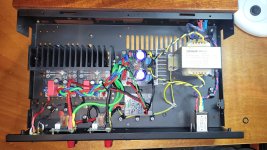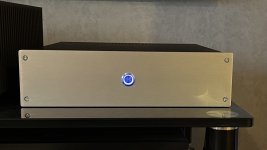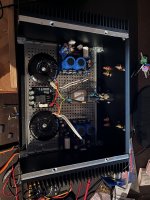My bad. The transformer is a custom with 2x 22-0-22VAC windings. If designed correctly there is not any difference to shout about between that and two seperate transformers (costing up to half as much again). Yes the IC amplifiers each have their own power supply. better power handling and less noisy rails as well as better channel seperation are all advantages here....
G'day Guys,
Here is one I made for a friend of mine earlier in the year.
LM1875 chips on home brew boards.
Home brew speaker protection based on Rod Elliot P33.
100VA transformer with 2x 15vac secondaries.
Lots of recycled wire and the power switch from a Wega 3 Group coffee machine.
Recycled PA amp chassis albeit with a fresh back panel I folded up from an old dishwasher.
Recycled Mahogany for the front panel with many coats of various danish oils and clear coat.








Here is one I made for a friend of mine earlier in the year.
LM1875 chips on home brew boards.
Home brew speaker protection based on Rod Elliot P33.
100VA transformer with 2x 15vac secondaries.
Lots of recycled wire and the power switch from a Wega 3 Group coffee machine.
Recycled PA amp chassis albeit with a fresh back panel I folded up from an old dishwasher.
Recycled Mahogany for the front panel with many coats of various danish oils and clear coat.








That is amazing work of art from so much recycling..... Hope it sounds just as great, too!
Last edited:
Hard to believe!Lots of recycled wire and the power switch from a Wega 3 Group coffee machine.
Recycled PA amp chassis albeit with a fresh back panel I folded up from an old dishwasher.
Recycled Mahogany for the front panel with many coats of various danish oils and clear coat.
I've found that coffee machines are a very good source for power switches and wire as everything is heavy duty.
Typically the power switches are rated at 15A at 230V.
The wire tends to be fat and 600V rated. I just salvaged some mains wire from inside the flex cable power cord on a coffee machine: 3core x2.5mm2.
This stuff is wonderful. Italian mains wire is much much better than the stuff available to me locally. The 2.5mm stuff is much more flexible and easy to work with than the 18awg stuff I can get from the local Jaycar. Much easier to twist etc. And free!
Also by the time you salvage a whole machine worth, there is often many colours not just brown, blue and green/yellow, and multiple gauges.
Dress everything up with some cheap PTFE braid off of ali express and you got some nice looking stuff.
Typically the power switches are rated at 15A at 230V.
The wire tends to be fat and 600V rated. I just salvaged some mains wire from inside the flex cable power cord on a coffee machine: 3core x2.5mm2.
This stuff is wonderful. Italian mains wire is much much better than the stuff available to me locally. The 2.5mm stuff is much more flexible and easy to work with than the 18awg stuff I can get from the local Jaycar. Much easier to twist etc. And free!
Also by the time you salvage a whole machine worth, there is often many colours not just brown, blue and green/yellow, and multiple gauges.
Dress everything up with some cheap PTFE braid off of ali express and you got some nice looking stuff.
I meant, its hard to believe that the final finished product uses recycled parts, it looks just like new!you got some nice looking stuff.
BTW I use PC SMPS Cables, but mine looks like the amp is giving forced birth to piglets with all its umbilical cords still hanging out in the open.
4 channel LM3886 with original BrianGT boards.
Case, transformer, etc. were left-over from another prototype.
Drives a pair of Alpair 6 (Gen 1) Sphere + closed-box woofers.
Crossover is just 1st order LP for the woofer.
Patrick
.
Case, transformer, etc. were left-over from another prototype.
Drives a pair of Alpair 6 (Gen 1) Sphere + closed-box woofers.
Crossover is just 1st order LP for the woofer.
Patrick
.
Attachments
About two years ago I made a ”Summer Amp” in close collaboration with Patrick.
- 2 x LM4780 per channel in bridged parallel mode
- fully balanced
- XEN LM4780 PCBs
- +/-20V rails with CRC for each channel
- 400VA Toroidy trafo
- XEN speaker protection fed from aux supply
Attachments
Last edited:
Beautifully laid out and excellent wiring!About two years ago I made a ”Summer Amp” in close collaboration with Patrick.
Runs cool even with just the small side panels as sinks with my listening levels and speakers. Thanks Patrick for this great amp! 😁
- 2 x LM4780 per channel in bridged parallel mode
- fully balanced
- XEN LM4780 PCBs
- +/-20V rails with CRC for each channel
- 400VA Toroidy trafo
- XEN speaker protection fed from aux supply
I don't see anything wrong with the enclosure . But I personally prefer black boxes and leave the fancy for inside..
4x LM1875 amplifier, modified XY boards (quite a lot of mods, should have made my own at this point 🤔).
Enclosure made from very old heatsinks, and random metals. Transformer is also reused from some old plastic age music centre.
Power supply about 27 Volts per rail without load. There is no power switch or volume control. It is intended to use with other amps in multiway system, with one switch for all of them, and volume control in filter stages, or at player.





Enclosure made from very old heatsinks, and random metals. Transformer is also reused from some old plastic age music centre.
Power supply about 27 Volts per rail without load. There is no power switch or volume control. It is intended to use with other amps in multiway system, with one switch for all of them, and volume control in filter stages, or at player.
My first build based on Kaltecs 100W TDA7293 ULTRA-LOW DISTORTION KIT. Measured distortion with REW 0.0058% THD at 1Khz, 1W


My second build based on Modulus 86. A lot more better sounding that my first build based on Kaltecs 100W TDA7293


Last edited:
Hello @Freedom666, I'm not an audiophile. I listened for years to a Yamaha RX-V650 on pure mode and I'll use it as reference for this comparison.
Kaltecs's amp was a little more resolving than the Yamaha. For my ears it was better, but not by much and I felt like the amp didn't live up to the level of praise shown on the creator's site, When increasing the volume, I felt like the amp lost some clarity,
I knew my Yamaha had 0.06% THD. A 0.00014% THD amplifier shoud be several times better than a 0.06% THD one, not marginaly better, isn't it? That's why I decided to measure Kaltecs's amp distortion and wasn't close to 0.00014%. Maybe my implementation wasn't good, I don't know... So, I decided to try Modulus 86.
For me, Modulus 86 is definitely better than Kaltecs's amp, a lot more transparent. No loss in clarity when increasing the volume, on the contrary, I felt like the clarity increased. The bass is deeper and controlled (I listen a lot to vocal trance), the voices are very clear, the highs are clear and smooth. For the first time I felt immersed listening to hi-res music on Qobuz.
Kaltecs's amp was a little more resolving than the Yamaha. For my ears it was better, but not by much and I felt like the amp didn't live up to the level of praise shown on the creator's site, When increasing the volume, I felt like the amp lost some clarity,
I knew my Yamaha had 0.06% THD. A 0.00014% THD amplifier shoud be several times better than a 0.06% THD one, not marginaly better, isn't it? That's why I decided to measure Kaltecs's amp distortion and wasn't close to 0.00014%. Maybe my implementation wasn't good, I don't know... So, I decided to try Modulus 86.
For me, Modulus 86 is definitely better than Kaltecs's amp, a lot more transparent. No loss in clarity when increasing the volume, on the contrary, I felt like the clarity increased. The bass is deeper and controlled (I listen a lot to vocal trance), the voices are very clear, the highs are clear and smooth. For the first time I felt immersed listening to hi-res music on Qobuz.
Last edited:
Hello,
There is only one way to do a proper test rather than the 'I made made it so it does'
https://jlh1969classa.blogspot.com/p/jlhtest.html
Cheers
There is only one way to do a proper test rather than the 'I made made it so it does'
https://jlh1969classa.blogspot.com/p/jlhtest.html
Cheers
- Home
- Amplifiers
- Chip Amps
- Chip Amp Photo Gallery












